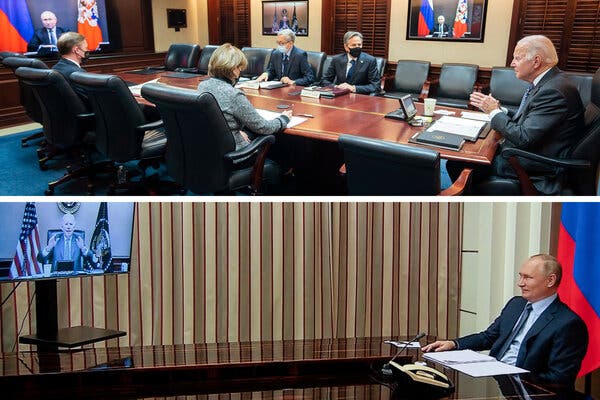
President Biden, in a high-stakes virtual meeting on Tuesday morning, warned President Vladimir V. Putin of Russia of economic consequences if he continued to escalate a military presence around Ukraine, according to a White House statement.
The diplomatic effort came as tens of thousands of Russian troops mass along the Ukrainian border, raising fears of an invasion.
“President Biden voiced the deep concerns of the United States and our European allies about Russia’s escalation of forces surrounding Ukraine and made clear that the U.S. and our allies would respond with strong economic and other measures in the event of military escalation,” according to the White House statement. “President Biden reiterated his support for Ukraine’s sovereignty and territorial integrity and called for de-escalation and a return to diplomacy.”
Jake Sullivan, the president’s national security adviser, described the president’s comments to reporters.
“He told President Putin directly that if Russia further invades Ukraine, the United States and our European allies would respond with strong economic measures,” Mr. Sullivan said.
He later added, “There was a lot of give and take, there was no finger wagging, but the president was crystal clear about where the United States stands.”
Mr. Sullivan said the administration was also prepared to send supplies and additional resources to Ukraine if Russia escalated its military presence.
Asked for specifics for the consequences facing Russia, Mr. Sullivan declined to go into detail. “I will look you in the eye and tell you as President Biden looked President Putin in the eye and told him today that things we did not do in 2014, we are prepared to do now,” Mr. Sullivan said.
The U.S. and Russian leaders began their conversation via video-link at 10:07 a.m., according to the White House, and it ended at 12:08 p.m. According to the White House, they also discussed ransomware and issues related to Iran. Before the call, Biden officials said the discussion would cover nuclear arms control, cybersecurity and Iran’s nuclear program. Mr. Sullivan said that Mr. Biden and Mr. Putin agreed to continue the dialogue on the issues discussed on Tuesday.
Mr. Biden would be speaking to Volodymyr Zelensky, the president of Ukraine, on Thursday, Mr. Sullivan said.
In a brief video of the opening moments of the call released by Russian state television, Mr. Putin said, “Greetings, Mr. President!”
“Good to see you again,” Mr. Biden responded warmly, after what appeared to be a brief connection glitch. “Unfortunately, last time we didn’t get to see one another at the G20. I am hoping next time we meet we do it in person.”
The video showed Mr. Putin seated at a long wooden desk, with Mr. Biden on a large video screen in front of him, and he waved to Mr. Biden as the call began. Mr. Putin took the call from his residence in Sochi, the Russian resort city on the Black Sea.
After the call ended, Mr. Biden was expected to hold a separate call with multiple U.S. allies, including President Emmanuel Macron of France, Chancellor Angela of Germany, Prime Minister Mario Draghi of Italy and Prime Minister Boris Johnson of Britain. The leaders had previously agreed to stay in contact on Russia’s deployment to Ukraine, according to the White House.
The virtual meeting with Mr. Putin was a crucial test for Mr. Biden, as he tried to protect Ukraine, a democratic ally whose security U.S. officials have promised to defend, and head off a major European security crisis.
Mr. Putin has complained that Ukraine poses a threat to Russia through its close military and political ties to the United States and European powers.
But Mr. Biden’s options are limited. He has no desire to send U.S. troops into battle on Ukraine’s behalf. Instead, Mr. Biden was to use the call to warn Mr. Putin of potentially severe economic consequences, according to a senior administration official who briefed reporters on Monday. The official would not offer details, but analysts say a full-fledged invasion could trigger a U.S. move to cut Russia off from the international financial system, a drastic measure reserved for extreme cases.
It is unclear, however, whether such warnings will deter the Russian president, who has weathered years of Western sanctions over past acts of aggression, including Mr. Putin’s 2014 annexation of Ukraine’s Crimean Peninsula and his longtime support for a pro-Russian separatist insurgency in Ukraine’s east.
U.S. officials believe that Mr. Putin has not decided whether to invade Ukraine. But the United States has disclosed intelligence showing that Russia’s military has developed a war plan that envisions as many as 175,000 troops pouring across Ukraine’s border — an invasion force that Ukraine’s military, despite U.S.-provided equipment and training, would have little ability to stop.




